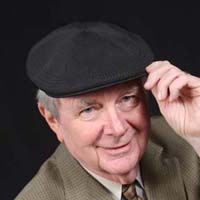 |
VO-BB - 20 YEARS OLD!
Established November 10, 2004
|
| View previous topic :: View next topic |
| Author |
Message |
Frank F
Fat, Old, and Sassy

Joined: 10 Nov 2004
Posts: 4421
Location: Park City, Utah
|
 Posted: Fri May 02, 2014 10:46 am Post subject: Posted: Fri May 02, 2014 10:46 am Post subject: |
 |
|
Thank you Chris. You have pointed out the proper use for processing... in Post or Mastering.
I ask you; would you prefer processed VO files prior to Post, or un-procesed audio when you go to mix? And why?
Frank F
_________________
Be thankful for the bad things in life. They opened your eyes to the good things you weren't paying attention to before. email: thevoice@usa.com |
|
| Back to top |
|
 |
captain54
Lucky 700
Joined: 30 Jan 2006
Posts: 744
Location: chicago
|
 Posted: Fri May 02, 2014 11:22 am Post subject: Posted: Fri May 02, 2014 11:22 am Post subject: |
 |
|
| Frank F wrote: | A large percentage of VO artists do not know a compressor from a D'esser. Knowing and understanding your equipment (software and hardware) is the most important thing imaginable for aspiring engineers.
Frank F |
As for me, no aspirations to be an audio engineer.. The only thing I aspire to is the ability to deliver audio, when requested, with a minimum of processing, producing a sweetened track with no remaining artifacts..
I grew up back in the day when hardware signal processing took up half the band equipment van.. So I get how it all works.. and where things go in a signal chain.
These days, as a voiceover person, I need to make my signal processing as idiot proof as possible.. with the least chance of F ing things up..so I can concentrate on delivering a performance.. again, FOR ME.. NR is way way too fiddly
Downward Expansion (via my Waves Renn Vox plug) is wonderfully simple way to apply downward expansion and compression, as well as giving the flavor of the old Fairchild and LA-2A vintage hardware. Two knobs.. that's it.... Also, I can easily match those settings in the Apple Audio Units Dynamic Processor plug..
_________________
Lee Kanne
www.leekanne.com
Last edited by captain54 on Fri May 02, 2014 11:37 am; edited 1 time in total |
|
| Back to top |
|
 |
Foog
DC

Joined: 27 Oct 2013
Posts: 608
Location: Upper Canuckistan
|
 Posted: Fri May 02, 2014 11:33 am Post subject: Posted: Fri May 02, 2014 11:33 am Post subject: |
 |
|
Could someone help this here Luddite understand the difference between downward expansion and a noise gate?
My understanding is that a noise gate detects when a signal gets below a given threshold, and then cuts it entirely, while downward expansion detects when a signal gets below a given threshold and then reduces it by whatever amount you tell it. If I'm misunderstanding the underlying mechanism of these two processes, could someone throw a (metaphorical, please!) wooden shoe into my head and set me right? |
|
| Back to top |
|
 |
vkuehn
DC

Joined: 24 Apr 2013
Posts: 688
Location: Vernon now calls Wisconsin home
|
 Posted: Fri May 02, 2014 12:09 pm Post subject: Posted: Fri May 02, 2014 12:09 pm Post subject: |
 |
|
As we moved from the days of tube-infested discrete devices on into solid-state devices and now more into modification-by-software, a person's choice of definitions for the things you asked about will depend on where in that progression you joined the party.
I don't believe myself to be an expert of the definitions, but here is mine:
Gating tends to be off/on, abrupt, open/shut. And typically very FAST ACTING.
Downward Expansion tends to be slower moving, dynamically adjusting rather sluggishly as it analyzes various attributes of the incoming signal, and may never be fully open or fully closed. It goes-with-the-flow. Also, folks using such devices in concerts and worship venues for live production will describe the two things differently than those dealing recordings, and folks dealing with music will describe the two functions differently that people dealing with speech only.
Aren't you glad you asked?  |
|
| Back to top |
|
 |
Stormtrooper 7
Contributor

Joined: 19 Oct 2008
Posts: 28
Location: Where I'm Needed...
|
 Posted: Fri May 02, 2014 12:17 pm Post subject: Posted: Fri May 02, 2014 12:17 pm Post subject: |
 |
|
Man this has turned into a great thread. I appreciate you guys' input on everything.
Thanks for the breakdown on the different versions Chris. I was reading the descriptions and thinking, I can use this and I can use that... but I can't get all of it right now. I would have to slowly add them as I could. I'm beginning to get back into the music stuff more. I love playing with this stuff. I have only one client that asks for over processed stuff. Go figure. It's the way they want it. Heavily compressed and gated so hard even rats and snakes can't get through.... But they seem to think it sounds great. I guess if it floats their boat...
When I got going in VO I found it was a whole different animal than music for working with I found out... Some things with music are forgiving. VO... not so much. I really didn't know a thing about some of these processors until John Weeks got with me on my sound chain. The man really knows his stuff. I had another engineer that was SUPPOSED to know what he was doing and charged me a bunch o' cash to help do pretty much nothing, and he was recommended by another VO person I used to talk to. The only good suggestion I got from him was getting a UA Solo 610 tube pre. Other than that his advice pretty much sucked. Once John figured out what I was shooting for, he helped me over the internet get my settings squared up and took the time to show me how different things sounded by processing my files in different ways, what to do and not to do. Eventually we came down to me getting a Bluebird mic and running through the pre to the dual Alesis to get the small compression and light limiting and that's it. It improved what I was putting out 200%. So if anyone needs any tips... there you go. John is the guy. |
|
| Back to top |
|
 |
Foog
DC

Joined: 27 Oct 2013
Posts: 608
Location: Upper Canuckistan
|
 Posted: Fri May 02, 2014 12:28 pm Post subject: Posted: Fri May 02, 2014 12:28 pm Post subject: |
 |
|
| vkuehn wrote: | | As we moved from the days of tube-infested discrete devices on into solid-state devices and now more into modification-by-software, a person's choice of definitions for the things you asked about will depend on where in that progression you joined the party. |
Personally, the ironic part of the whole move to solid state is that I spent the 80s and 90s playing bass and bass fiddle in various bands and NEVER had a single piece of equipment with a tube in it. It is only now, well into the new millennium where EVERYTHING is digitized that I finally have something resembling a tube amp (the preamp for my mic). And, of course, I love it to bits!
| vkuehn wrote: | Gating tends to be off/on, abrupt, open/shut. And typically very FAST ACTING.
Downward Expansion tends to be slower moving, dynamically adjusting rather sluggishly as it analyzes various attributes of the incoming signal, and may never be fully open or fully closed. It goes-with-the-flow. Also, folks using such devices in concerts and worship venues for live production will describe the two things differently than those dealing recordings, and folks dealing with music will describe the two functions differently that people dealing with speech only.
Aren't you glad you asked?  |
I'm always glad I asked! As my dear grandpa never used to say: There are no stupid questions, only stupid people.
So here is my follow-up, hopefully not stupid question: if I am not applying the process live, then is it still "slow" or "fast", or do those terms no longer apply? My instinct (never wrong, rarely right!) tells me that the only thing that determines the speed of the expansion that I apply this way to the track in my DAW is the attack and decay settings. |
|
| Back to top |
|
 |
vkuehn
DC

Joined: 24 Apr 2013
Posts: 688
Location: Vernon now calls Wisconsin home
|
 Posted: Fri May 02, 2014 1:48 pm Post subject: Posted: Fri May 02, 2014 1:48 pm Post subject: |
 |
|
| Foog wrote: |
if I am not applying the process live, then is it still "slow" or "fast", or do those terms no longer apply? My instinct (never wrong, rarely right!) tells me that the only thing that determines the speed of the expansion that I apply this way to the track in my DAW is the attack and decay settings.
|
I could easily get beyond my pay-grade very quickly here. Slow and Fast refer to the SPEED of the attack and/or decay.
Going back to when we used make our own vacuum tubes out of well cured oak lumber (a bit of old broadcast engineer humor there) this terminology came from the length of time it took for a voltage to build up or leak out of a circuit consisting of a resistor and a capacitor, with the voltage at any given millisecond telling the vacuum-tube how much to amplify. (I knew you would be glad you asked.)
Obviously in this day and age of a computerized algorithm plowing through a 60 second digital recording in maybe 4 to 9 seconds, there is no voltage building or dissipating. And if you are using a "stack" and applying a process to digitized sound in real time, we have no voltages to build or leak.
The mental block that has plagued me for several years is that when I take my mouse and slide the visual fader controls for attack and delay times, the actual behavior that results does not always do what my crusty old brain expected to happen if I had applied the same settings to an old vintage 1948 piece of audio gear.
I have read articles from purists in the photography world who complain that contrast adjustments and other settings in programs like Photoshop do not always bring the same kind of results that we got by making the same changes when we were waist deep in stinky old chemicals in a dark-room with the little reddish light. Sometimes you are a step ahead of the rest of us if you have never done all these things the original old-fashioned way. You don't suffer from un-realized expectations.
Just jump in and play with the settings. Never adjust your ORIGINAL file. Make multiple copies and try multiple settings. You will eventually develop an intuitive ability to choose settings. (If you live long enough!) |
|
| Back to top |
|
 |
ricevoice
Cinquecento

Joined: 28 Dec 2007
Posts: 532
Location: Sacramento, CA
|
 Posted: Fri May 02, 2014 3:28 pm Post subject: Posted: Fri May 02, 2014 3:28 pm Post subject: |
 |
|
| Frank F wrote: | | I ask you; would you prefer processed VO files prior to Post, or un-procesed audio when you go to mix? And why? |
Definitely unprocessed, so it's easier for me to sculpt to my liking. Everyone has their own way of doing things. I prefer dialing in the EQ prior to compressing... especially when it comes to rolling off the low end, I don't want those unwanted frequencies affecting the compressor. If you send v-o with heavy compression on it, that option is taken out of my hands. Now, a little sweetening on the raw files is fine... a smidge of EQ and/or light compression just to smooth it out a little. But once you send me heavily compressed voice, there's no plugin that will magically uncompress it. Which leaves me having to do extra work to try to get it to sit right in the mix.
A lot of the post I do is radio imaging. One client of mine got a new station voice. Great big pipes... and compressed to hell! I finally had to have the guy take apart his mic chain and disconnect his outboard compressor in order for me to be able to do with the v-o what I wanted. In his defense, his boss at his station loved the super-compressed sound, so he assumed all clients would want that.
Also, a word of warning with regards to Ozone 5 and Alloy 2... be careful with the multi-band compressors. In most instances, a little goes a long way, and it's very easy to try doing too much with them and completely screwing up the sound.
_________________
Chris Rice - Noisemaker
www.ricevoice.com |
|
| Back to top |
|
 |
Foog
DC

Joined: 27 Oct 2013
Posts: 608
Location: Upper Canuckistan
|
 Posted: Fri May 02, 2014 4:33 pm Post subject: Posted: Fri May 02, 2014 4:33 pm Post subject: |
 |
|
| vkuehn wrote: | | Going back to when we used make our own vacuum tubes out of well cured oak lumber (a bit of old broadcast engineer humor there) |
I'm reminded of one of my favourite radio programmes of all time: The Great Eastern. It was a CBC show that aired "broadcasts" from a fictional Newfoundland radio station that used a coal-fired transmitter.
| vkuehn wrote: | | Just jump in and play with the settings. Never adjust your ORIGINAL file. Make multiple copies and try multiple settings. You will eventually develop an intuitive ability to choose settings. (If you live long enough!) |
My problem is that I second guess myself altogether too much to feel comfortable with my choices. Intuitive tweaking is beyond me, and may well stay that way for a good long time. I have, however, come up with what I believe is a set of presets that are reasonably unobtrusive. I apply them to my P2P auditions pretty much as a matter of course now (with, as I mentioned before, light compression added if the client looks to be an audio "outsider" as it were).
| ricevoice wrote: | | But once you send me heavily compressed voice, there's no plugin that will magically uncompress it. |
This saddens me. The thing that first drew my attention to iZotope was the claim that they can do exactly this. I have some demo material that is TERRIBLY overcompressed, and was hoping that I could tweak it to make it a bit less (to my ears) awful.
One question for everyone here, especially those who have worked on the production end of things: What am I better off using - a bit of barely there downward expansion, or a bit of barely there noise reduction tailored to my room noise? (assuming that my main concern is that I want to clean things up a tiny bit, but I still want to submit the "rawest" possible raw audio.) |
|
| Back to top |
|
 |
Frank F
Fat, Old, and Sassy

Joined: 10 Nov 2004
Posts: 4421
Location: Park City, Utah
|
 Posted: Fri May 02, 2014 5:16 pm Post subject: Posted: Fri May 02, 2014 5:16 pm Post subject: |
 |
|
Thank you once again Chris. I must have said this a thousand times but somehow when it comes from another set of lips (fingers) it drives the message home.
Please remember this when we had tubes and outboard gear to play with; we we had Real 3D audio. Today's world of digitized 1's and O's which represent audible sounds; is 2D. Changing analog 3D audio to digitized 2D audio leaves 2D audio. It is flat and lacks depth. I use this analogy to define a lot of software processing and usually will play with my favorite piece of audio gear; the Maag Audio PreQ4 and EQ2. Then I will process the same original audio with the software plugin of PreQ4 and have a person listen to the differences and the similarities.
Taking this analogy to the extreme we jump to Noise Gates, Noise Reducers, Compressors, and the like inside the software arena (such as Izoptope). What is left of processed digital audio, no matter how you define it, is 2D audio with no transients, no harmonics, sounds flat, and lacks depth. None of these can you add to your recording with a digital processor, although many people try.
Now, as I stated early on in this thread, ... "Radio folks will disagree and argue vehemently about how they over-process files to make it sound like - radio". Folks who come from radio and are new to the VO world will argue until they are blue in the face; the need for processing. And, everyone of these folks will argue longer about the best way to create "the right sound".
I only have one more thing to add to this post. For VO artists; keep it clean, keep it simple, and keep it real. Nothing else will work well for your clients.
Frank F
_________________
Be thankful for the bad things in life. They opened your eyes to the good things you weren't paying attention to before. email: thevoice@usa.com |
|
| Back to top |
|
 |
verbcrunch
Contributor III

Joined: 22 Aug 2006
Posts: 97
Location: Boston, MA
|
 Posted: Mon May 05, 2014 1:36 pm Post subject: Posted: Mon May 05, 2014 1:36 pm Post subject: |
 |
|
I swear by iZotope, especially Nectar. Indispensable tool for VO. Dial in as much or as little processing as you need. De-breath, De- Ess, De- Pop, Gate, multiple compressors with ability to parallel process different flavors, limiters, EQ's, saturation.. Use one, a few, or all, arranging the processing sequence any way you like. Full blown version more than "Elements", but is still a bargain for what it can do.
If you have further uses for excellent audio processing tools, Ozone 5 Advanced and RX3 advanced are sublime. I frequently use RX3's "De-Click" to eliminate mouth noises. Even if you're a purist who feels any processing ruins the sanctity of your product, there's no audio producer on earth who won't appreciate NOT hearing mouth noises on your voice track.
Just use it surgically where needed, no where else, since any noise reduction can degrade the integrity of your audio.
That is all. Thanks for your time.
Jeff B
_________________
Jeff Berlin
Humble Voice Guy
http://www.jeffberlin.com |
|
| Back to top |
|
 |
|
|
You cannot post new topics in this forum
You cannot reply to topics in this forum
You cannot edit your posts in this forum
You cannot delete your posts in this forum
You cannot vote in polls in this forum
|
Powered by phpBB © 2001, 2005 phpBB Group
|



